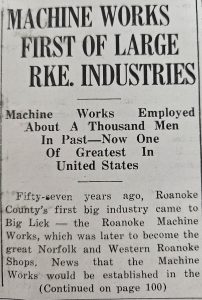
Machine Works Employed About A Thousand Men In The Past-Now One Of Greatest In United States
From the 1938 centennial edition of The Times-Register
Fifty-seven years ago, Roanoke County’s first big industry came to Big Lick-the Roanoke Machine Works, which was later to become the great Norfolk and Western Roanoke Shops. News that the Machine Works would be established in the little village was received with rejoicing by the citizens of the entire county and surrounding territory.
Described in the old days as “the greatest car and locomotive manufacturing plant in the South,” the Roanoke Machine Works was organized on November 19, 1881. Construction started in 1882, and in the following year the plant was completed. The capitol stock of the company was $5,000,000. This “great plant, constructed for the purpose of building and repairing engines and cars of the Norfolk and Western and the Shenandoah Valley railroads, as well as doing similar contract work for other railroads of the land,” was the talk of the State.
The machine works employed about a thousand men and gave an impetus to business of every kind. A historian of the day, describing the beneficial results of the town’s new industry wrote in part as follows:
Shops Started Prosperity
“The building of these shops and the installation of their equipment placed the general business conditions of the city on a solid foundation and its progress from now on is assured.” He was right. The young town and county made tremendous strides. Dozens of new homes were built. New stores were opened. Big Lick changed its name to Roanoke and definitely established itself as the trading center for the rapidly developing Empire of Southwestern Virginia.
During the more than five years of its existence, the Roanoke Machine Works, now Norfolk and Western shops, has grown to be one of the largest, most modern and efficiently operated railroad shops in the Untied States, employing several thousand men and spread out over an area of 145 acres. While primarily repair shops, the skilled mechanics of the gigantic plant can turn out “everything from a pin to huge, modern locomotives weighing a million pounds.”
The Roanoke Machine works as originally constructed consisted of a smith shop, machine shop, erecting shop, foundry, planning mill, lumber dryer, storehouse and car roundhouse. Within the past several decades these facilities have undergone a complete metamorphosis. Shop structures have been rebuilt and enlarged. New departments have been added. Outdated equipment has been replaced by the most modern and efficient machinery that can be bought. The working conditions of shop employees are unexcelled in any similar plant. Safety and accident prevention is the watchword of every worker.
Spent $2,500,000 In 1923
The development of the Roanoke shops is a saga of progressive improvement, evidenced by the fact that since 1923 alone the Norfolk and Western has expanded approximately $2,500,000 for new, modern shop machinery, and several hundred thousand dollars for new shop buildings.
The machinery in the old machine shop was belt driven from a double crank, horizontal steam engine. Light was furnished by gas jets, and candles were used on the machines by the workmen. That is the picture of the old days. During the years the railroad has made constant improvement in equipment, working conditions, and efficiency. In 1926, the N & W expended $655,000 for the construction of a new machine shop building, which is today considered one of the most modern machine shops in the Untied States.
The erecting shop and foundry have been consistently improved and enlarged. The smith shop, which was enlarged in 1902, 1910, and 1914, was replaced in 1930 with a new modern, fireproof building at a cost of $235,000. When the new structure was erected, all the machinery was rearranged for greatly increased efficiency of operation. Two heavy forging furnaces, and a preheating furnace for burning pulverized coal, and other up-to-date facilities were installed.
Still, another great improvement in the shop plant was the construction of a new boiler shop in 1924 at an expenditure of $173,000. Modern in every respect, this shop built the first completely electrically welded locomotive firebox in the country.
Other major construction projects and betterments made in the Roanoke Shops since 1923, include a roundhouse, $400,000; oil house, $65,000; storehouse, $45,000; scrap building wharf, etc., $36,000; and a two-story addition to the commissary building, $46,000.
In addition to those already mentioned, the railroad has many other departments in its local shops; a tank shop, wheel and axle shop, frog shop, paint shop, passenger car shop, freight car shop, and planning mill.
While the Norfolk and Western has forged steadily ahead in a progressive program of shop betterment, it has made extensive additions to other terminal facilities, general offices, etc.
In 1931, the railroad completed a modern new office building at a cost of more than $800,000. This structure is regarded as one of the finest office buildings in the State.
During 1936 the N & W completed a new classification or storage yard and other facilities in the West End Yards at an outlay of approximately $300,000, which greatly expedited the movement of traffic in and out of Roanoke and increased the efficiency of the terminal. The project included 1,400-foot extensions of 14 tracks in the Park Street Yard , increasing the capacity from 60 to 85 or 90 cars to each track; the construction of a classification and storage yard with nine new tracks, holding 20 cars each; and the extension of six eastward forwarding tracks 1,300 feet, increasing the capacity of each track from 70 to 100 cars.
The Norfolk and Western has in Roanoke total classification tracks with a capacity of 6,100 cars, and a total terminal mileage of 135 miles.
-Prepared by Lisa King




